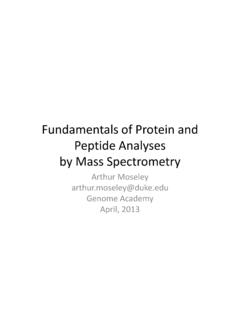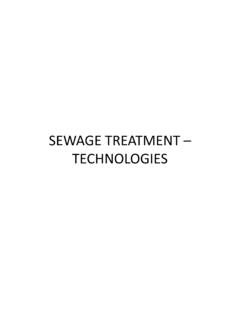Transcription of Practical LC-MS Troubleshooting and Maintenance: A Primer
1 Practical LC-MS Troubleshooting and Maintenance: A Primer Sue Abbatiello, The Broad Institute Tom Blau, Ion Technology Support, Inc. Will Thompson, Duke University General Troubleshooting Guidelines Visual Inspection is Key! Start By Breaking the System Down Having a BASELINE for all metrics is critical to proper Troubleshooting -Logbooks to track problems and solutions -Reference Values for Instrument Readbacks -System Suitability Break the System Down Review All Available Data Chromatogram, Mass Spectra, Pressure Traces, Error Logs Isolate Major System Components Mass Spectrometer (Infusion Analysis) LC (Standard Mixture) LC System Critical Tool: Standard Mixture Separation! Critical Readbacks: Pressure Traces Flow measurement Injection Check Isolate Problem To: Column(s) Tubing Autosampler Injector Valves Pump Mass Spectrometer Critical Tool : Infusion!
2 Critical Readbacks: Voltages Vacuum Gauges Detector Signal Isolate Problem To: Ionization/Source Vacuum Calibration Mass Analyzer Detector What to Learn From Your Engineer The time to gather key information to enable Troubleshooting is at the time your instrument is Compare to Installation Values (CIV) Also, your engineer probably has Troubleshooting documents that are not widely distributed . Ask for them! (It can t hurt) Vacuum Settings (all regions) Voltage Readbacks (screenshots of good values) Source Boards Power Supplies Tune Mixes to Use (and good values) Sensitivity, Resolution, Stability Mass Calibration, S/N AutoTune/Calibration Best Practices Chromatographic Performance Pressure Range for X Column Peak Width/Resolution of critical pr RT Stability Error Log Message Descriptions PM Schedule for Your Use-Case How Best to Find Spare Parts Restrictions on Solvents, pH, etc with your LC What is System Suitability?
3 "System suitability testing is an integral part of many analytical procedures. The tests are based on the concept that the equipment, electronics, analytical operations and samples to be analyzed constitute an integral system that can be evaluated as such. System suitability test parameters to be established for a particular procedure depend on the type of procedure being validated". (FDA) The checking of a system, before or during analysis of unknowns, to ensure system performance (International Conference on Harmonization of Technical Requirements for Registration of Pharmaceutical for Human Use [ICH]) Simply put: Analysis of a known sample to assess system performance Helps to identify when the system is not working GO No GO Define Pass/Fail Criteria What are metrics of a system suitability protocol?
4 MS response, sensitivity Mass accuracy Precision Retention time Peak shape, FWHM Chromatographic resolution MS LC How can you assess normal system performance? Tune/calibrate LC and MS components Monitor variability of metrics over several injections Always use the same method for LC and MS, even if it is different than your sample method Ask the vendor for performance specifications for both LC and MS parameters Note when system performance deviates Compare to other systems running the same system suitability protocol How can you evaluate system suitability data (for free)? *: NIST metrics: Skyline: Panorama: Retention Time Viewer: Database searches for peptide ID Excel Any longitudinal data tracking system Check with your instrument vendor * Thermo instruments only Summary Set up a system suitability protocol that works for you and use it Don t waste precious sample without making sure your LC-MS system is working Use system suitability to monitor changes in hardware, software, any changes at all Keep examples of poor system suitability data to help trouble shoot future issues General LC Troubleshooting Tips, Tricks & Maintenance N Autosampler Is there air in the syringe?
5 Is sample being picked up from vial? Does the pressure trace during injection look normal? Is the flow rate through the autosampler normal? Y Y N Check the AS valve and rotor Is the chiller on? Y Y Check volume of needle wash solvent and sample. Make sure syringe is attached correctly. Check syringe seal and plunger. N N N Drop in pressure indicates leak, air, or solvent with lower viscosity in system. Pressure spike indicates blockage or solvent of higher viscosity in system Problem may be with HPLC and flow rate. Check flow rate directly from pump. Check flow rate after autosampler. Loss of flow may indicate leak in AS. Check temperature with thermometer. Check temp settings. HPLC Pumps Y Is there solvent in the reservoirs? Does the pressure trace look normal? Is the flow rate normal? Are peaks eluting with reproducible retention times Y Y N See next slides for examples Are peak shapes symmetrical?
6 Y N Replace solvents and purge. Degas solvents if necessary. N N N Check flow rate directly from pumps, then through autosampler, look for leaks May have air in the system or degasser not working. Check solvent mixer, pump seals or check valves. Check all connections post-column for voids. Go to Columns & Hardware section Columns & Hardware Y Are peak shapes symmetrical? Are peaks the usual width? Is ESI stable? Is the system clogging frequently? Y Y N Check gradient delivery and flow rate from HPLC. N Check all connections post-column. Assess column age. Run standard sample. N Y Check high voltage connection. Is ESI tip clean? Is ESI tip leaking? Check tubing cuts (fused silica, PEEKsil, PEEK or stainless steel). Try in-line filter. Check rotors for wear. Centrifuge samples prior to analysis. MS System: A Troubleshooting Workflow and Common Problems System Checks Infusion (ESI +/-) ( Vendor-recommended tune Mix.)
7 NaCsI, PPG, PolyTyrosine, GluFib, LeuEnk, etc) 1. Sensitivity Check (compare to installation values, CIV) Pass Tune Source Parameters ( Fresh /Recovered Tune Page) ESI Emitter Position/Leaks/Stability Source and Cone/Transfer Tube and Skimmer Cleanliness Detector Gain or Voltage Poor Vacuum Fresh Tune Solution! Fail Pass Fail ESI Sprayer Stability (Arcing?) Transfer Optics (Entrance Hex/Quad, Q1) Charging Poor Vacuum Syringe Pump 3. Mass Resolution Check (CIV) Pass Go to #2 (Stability) Pass Go to #3 (Resolution) Poor Analyzer Vacuum MS Analyzer Tune Parameters (Recovered Tune Page) High V Power Supply Fail Pass 4. MS/MS Fragmentation Check (CIV) Go to #4 (Fragmentation) Pass Key Most Common Causes for Failure Continued next MS System: A Troubleshooting Workflow 2.
8 Signal Stability Check (Signal should not show significant decrease in ~minutes) 4. MS/MS Fragmentation Check (CIV) Pass Fail No Collision Gas Improper Collision Energy MS1 Transmission Window or Calibration Collision Cell Power Supply 5. Calibration Go to #5 (Calibration) System Checks Most Common Causes for Failure Key MS Troubleshooting Workflow, Pass Fail Nominal Mass Calibration off Corrupt Tune Page Lab/Instrument Temperature 6. System Suitability Pass Fail Troubleshoot LC OR Coupling from LC to MS Pass Go to #6 (System Suitability) Pass READY TO RUN! Remember VISUAL INSPECTION is key at all steps! Can you think of other, less common failures for these system checks? Infusion (ESI +/-) ( Vendor-recommended tune Mix. NaCsI, PPG, PolyTyrosine, GluFib, LeuEnk, etc) MS System: A Brief Word On Communications Troubleshooting workflow assumes basic PC-to-Embedded PC Communication is Intact But what if I don t have PC to Instrument Communication?
9 Methods to Check for Communications Readbacks (should update regularly and have slight changes) Speed Readings Supplies Controls (watch for response) Voltage on/off source parameters Energy low/high if infusing What to Do if No Response in doubt, reboot! (PC and Instrument embedded PC) cable connections (ethernet) cards reboot of instrument electronics Tune Source Parameters ( Fresh /Recovered Tune Page) ESI Emitter Position/Leaks/Stability Source and Cone/Transfer Tube and Skimmer Cleanliness Detector Gain or Voltage Poor Vacuum Fresh Tune Solution Troubleshooting Typial Causes of Failure (Sensitivity) Ion Transmission is drastically effected by source tuning parameters. Check values against installation values. If same, consider starting a fresh tune page since tune files can become corrupt.
10 Emitter position and spray stability is the both the easiest way to have a problem and to fix one. If possible, record the micrometer settings on your ESI position to make sure it is in the right place. If spray is sputtering, adjust voltage, gases. Consider cleaning or replacing sprayer components. Check for leaks. VISUAL inspection is key. Dirty skimmer and transfer tubes can kill sensitivity. Clean stainless steel components with sonication in 50/50 MeOH/water with 1% Formic acid (gentle) or 30% nitric acid (aggressive). Wash thoroughly. Voltage or gain effects all types of detectors, from EMT on QqQ, to MCP/ADC on Tof, to Electron Multiplier for automatic gain control (ion gating) on trapping instruments. Run manual or automatic gain checks. Mean free path dictates that MS systems need vacuum to operate, and incomplete vacuum will kill ion transmission.






